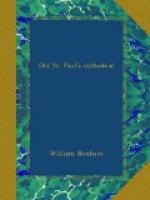It was at this period that the Deanery was occupied by the first man of letters it had yet possessed, Ralph de Diceto. His name is a puzzle; no one has as yet ascertained the place from which it is taken. Very probably he was of foreign birth. When Belmeis was made Bishop of London in 1152, Diceto succeeded him as Archdeacon of Middlesex. His learning was great, and his chronicles (which have been edited by Bishop Stubbs) are of great historical value. In the Becket quarrel Diceto was loyal to Foliot, but he also remained friendly with Becket. In 1180, he became Dean of St. Paul’s. Here he displayed great and most valuable energy; made a survey of the capitular property (printed by the Camden Society under the editorship of Archdeacon Hale), collected many books, which he presented to the Chapter, built a Deanery House, and established a “fratery,” or guild for the ministration to the spiritual and bodily wants of the sick and poor. He died in 1202. He wrote against the strict views concerning the celibacy of the clergy promulgated by Pope Gregory VII., and declared that the doctrine and the actual practice made a great scandal to the laity. Dean Milman suspects that he was much moved herein by the condition of his own Chapter.
In 1191, whilst King Richard I. was in Palestine, his brother John summoned a council to St. Paul’s to denounce William de Longchamp, Bishop of Ely, to whom Richard had entrusted the affairs of government, of high crimes and misdemeanours. The result was that Longchamp had to escape across sea. At length the King returned, but the Londoners were deeply disaffected. William FitzOsbert, popularly known as “Longbeard,” poured forth impassioned harangues from Paul’s Cross against the oppression of the poor, and the cathedral was invaded by rioters. Fifty-two thousand persons bound themselves to follow him, but Hubert, Archbishop of Canterbury, met the citizens in the cathedral, and by his mild and persuasive eloquence persuaded them to preserve the peace. FitzOsbert, finding himself deserted, clove the head of the man sent to arrest him, and shut himself up in the church of St. Mary-le-Bow. His followers kept aloof, and a three-days’ siege was ended by the church being set on fire. On his attempt to escape he was severely wounded by the son of the man he had killed, was dragged away, and burned alive. But his memory was long cherished by the poor. Paul’s Cross was silent for many years from that time.
In 1213, a great meeting of bishops, abbots, and barons met at St. Paul’s to consider the misgovernment and illegal acts of King John. Archbishop Langton laid before the assembly the charter of Henry I., and commented on its provisions. The result was an oath, taken with acclamation, that they would, if necessary, die for their liberties. And this led up to Magna Charta. But it was a scene as ignominious as the first surrender before Pandulf, when Pope Innocent accepted the homage of King John as the price of supporting him against his barons, and the wretched King, before the altar of St. Paul, ceded his kingdom as a fief of the Holy See. The Archbishop of Canterbury protested both privately and publicly against it.




